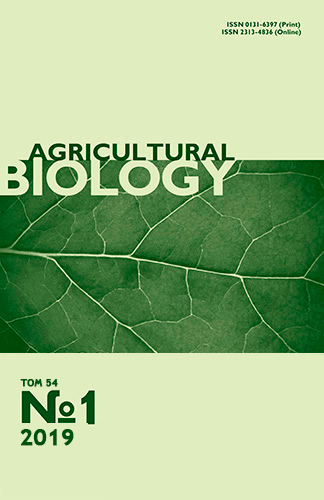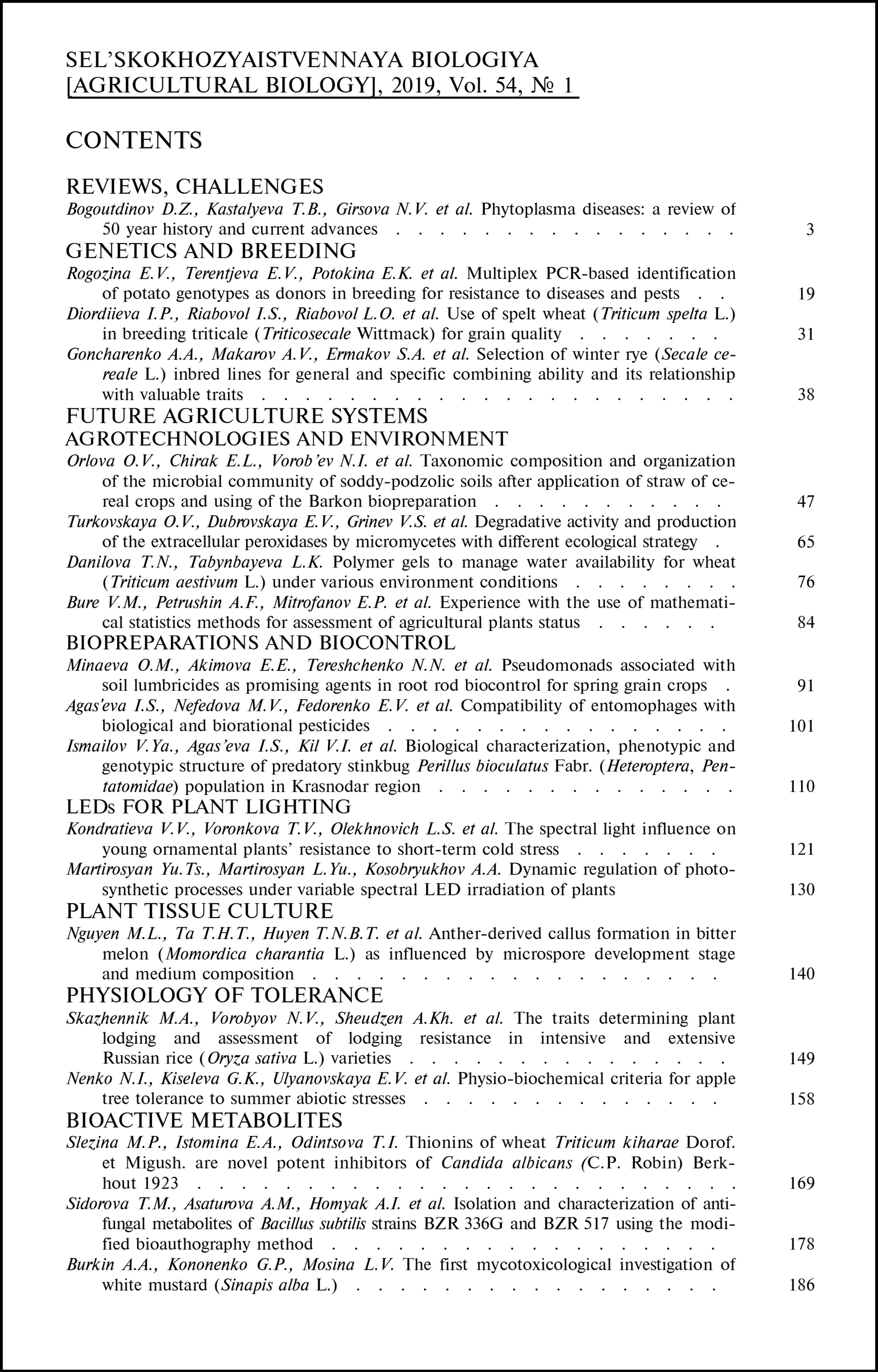doi: 10.15389/agrobiology.2019.1.121eng
UDC 632.937:632.937.33:575.21
THE SPECTRAL LIGHT INFLUENCE ON YOUNG ORNAMENTAL PLANTS’ RESISTANCE TO SHORT-TERM COLD STRESS
V.V. Kondratieva, T.V. Voronkova, L.S. Olekhnovich, G.F. Bidyukova,
O.L. Enina, O.V. Shelepova
Tsitsin Main Botanical Garden RAS, 4, Botanicheskaya ul., Moscow, 127276 Russia, e-mail lab-physiol@mail.ru (✉ corresponding author), winterness@yandex.ru, shelepova-olga@mail.ru
ORCID:
Kondratieva V.V. orcid.org/0000-0003-3934-9288
Bidyukova G.F. orcid.org/0000-0002-0740-947X
Voronkova T.V. orcid.org/0000-0002-6112-271X
Enina O.L. orcid.org/0000-0002-8971-6384
Olekhnovich L.S. orcid.org/0000-0002-3230-0038
Shelepova O.V. orcid.org/0000-0003-2011-6054
Received July 10, 2018
LED light sources allow for variations in the spectral composition which makes it possible to evaluate the effect of light with narrow spectral width on plants performance. The combination of such lighting with natural lighting can significantly change the direction and intensity of metabolic processes in plants to adapt to changing environmental conditions. In the present paper, we showed for the first time that additional illumination with narrow-spectrum light allows the seedlings of ornamental plants to successfully adapt to cold stress. The aim of our work was to estimate the effect of red light (600 nm) and blue light (400 nm) from LED panels on adaptation of tagetes (Tagetis panula L.) cultivar Karmen, snapdragon (Antirrhinum majus nanum L.) cultivar Flora shower white and petunias (Petunia hybrida L.) cultivar Mambo blue seedlings to spring frosts when transplanting to open ground. These plants are often used in landscaping settlements and are exposed to low positive and zero temperatures, especially in the first days after transplanting to open ground. The experiment was carried out in a greenhouse (18 °С, humidity 85 %). During thirty days, one third of the plants were additionally red lightened (RL), and one third ones were blue lightened (BL) using Focus MC2 (JCC-12) LED panels (Russia) for 12 hours after the end of daylight hours. A third of the plants were grown under natural light only (C). After the end of the LED illumination period, a half of the plants in each variant were placed in the chamber with 2 °С for 24 hours. The second half plants were control without cooling. The effectiveness of lighting was assessed by the decorative state of plants, the change in the selective permeability of membranes, the content of salicylic and abscisic acids, the triggers of the cascade of protector reactions in the leaf tissues, and the survival of plants transplanted to the open ground. Our experiments showed that additional lightening with blue and red light contributes to seedling resistance to low positive temperatures. In RL- and BL-exposed plants, the leaf turgor was quickly restored, the habitus of plants was preserved, and budding began. In these variants, the cell membrane stabilization was noted, i.e. i.e. an increase in the outlet of potassium ions was two times lower than in the control. The changes of cell membranes was estimated by output of electrolytes from the 0.25 g leaves measured potentiometrically (ITAN, OOO SPE Tom’analit, Russia) with an ion-selective electrode (Elit-031, OOO NIKO ANALIT, Russia). Abscisic acid (ABA) and salicylic acid (SA), the important triggers and tuners of cascade responses to abiotic stress, were determined in a single sample, at the final stage, by isocratic HPLC method (Stayer system, ZAO Aquilon, Russia), with column PR-18 (250/4.6 mm) (Phenomenex, Inc., USA). ABA concentration in leaves of RL-exposed tagetes plants increased 4.4-fold and the SA 3.3-fold compared to the control, and in BL-exposed tagetes only SA content increased 1.4-fold (p ≤ 0.05). After cold exposure, the RL plants restored turgor, while in BL the restoration was slower and the leaf infiltration began. Similar changes were in control. In snapdragons and petunias, blue light also caused a 1.5-fild increase in the SА level in leaves, while red light led to insignificant changes. After cold stress, the RL- and SS-exposed plants of these species quickly recovered, their habitus was almost as in unaffected plants. The control plants recovered more slowly, and their decorativeness was worse. The survival rate of RL plants replanted to open ground was 100 % for tagetes and petunias, and 85-90 % (p ≤ 0.05) for snapdragons. In BL-exposed plants, these indicators were 70 % (p ≤ 0.05) for tagetes and 85-90 % (p ≤ 0.05) for petunias. The rooting of the control plants not exposed to RL or BL and subjected to the cold stress reached 60-70 % (p ≤ 0.05). The physiological and biochemical changes that we identified in the leaves of the seedlings of ornamental plants suggest that spectral light facilitates the modulation of plant metabolism and activates non-specific protective mechanisms aimed at preserving the ionic and redox cell homeostasis. An exposure of growing seedlings of ornamental plants to light with narrow spectral width, in addition to natural light, can be very effective to reduce the loss of re-planted plants from spring frosts.
Keywords: Tagetis panula L., tagetes cv. Karmen, Antirrhinum majus nanum L., snapdragon cv. Flora shower white, Petunia hybrida L., petunias cv. Mambo blue, narrow spectral light, cold stress, cell membranes, water soluble carbohydrates, salicylic acid, abscisic acid, ABA.
REFERENCES
- Olle M., Viršilė A. The effect of light emmiting diode lighting on greenhouse plant grows and quality. Agricultural and Food Science, 2013, 22(2): 223-234 CrossRef
- Avercheva O.V., Berkovich Yu.A., Erokhin A.N., Zhigalova T.V., Pogosyan S.I., Smolyana S.O. Fiziologiya rastenii, 2009, 56(1): 17-16 (in Russ.).
- Vanninen I., Pinto D.M., Nissinen A.I., Johansen N.S., Shipp L. In the light of new greenhouse technologies: 1. Plant-mediated effects of artificial lighting on arthropods and tritrophic interactions. Annals of Applied Biology, 2010, 157(3): 393-414 CrossRef
- Colquhoun T.A., Schwieterman M.L., Gilbert J.L., Joworski E.A., Langer K.M., Jones C.R., Rushing G.V., Hunter T.M., Olmsted J., Clark D.G., Folta K.M. Light modulation of volatile organic compounds from petunia flowers and select fruits. Postharvest Biology and Technology, 2013, 86: 37-44 CrossRef
- Causin H.F., Jauregui R.N., Barneix A.J. The effect of light spectral quality on leaf senescence and oxidative stress in wheat. Plant Sci., 2006, 171(1): 24-33 CrossRef
- Chinnusamy V., Zhu J., Zhu J.-K. Gene regulation during cold acclimation in plants. Physiologia Plantarum, 2006, 126(1): 52-61 CrossRef
- Crosatti C., Rizza F., Badeck F.W., Mazzucotelli E., Cattivelli L. Harden the chloroplast to protect the plant. Physiologia Plantarum, 2013, 147(1): 55-63 CrossRef
- van Gelderen K., Kang C., Pierik R. Light signaling, root development, and plasticity. Plant Physiol., 2018, 176(2): 1049-1060 CrossRef
- Kreslavskii V.D., Karpentier R., Klimov V.V., Murata N., Allakhverdiev S.I. Biologicheskie membrany, 2007, 24(3): 195-217 (in Russ.).
- Trotta A., Rahikainen M., Konert G., Finazzi G., Kangasjärvi S. Signalling crosstalk in light stress and immune reactions in plants. Philosophical Transactions of the Royal Society B: Biological Sciences, 2014, 369(1640): 20130235 CrossRef
- Pennycooke J.C., Cox S., Stushnoff C. Relationship of cold acclimation, total phenolic content and antioxidant capacity with chilling tolerance in petunia (Petunia ½ hybrida). Environ. Exp. Bot., 2005, 53(2): 225-232 CrossRef
- Patton A.J., Cunningham S.M., Jolenec J.J., Reicher Z.J. Difference in freeze tolerance of zoysiagrasses. II. Carbohydrate and proline accumulation. Crop Sci., 2007, 47(5): 2170-2181 CrossRef
- Crossatti C., Polverino de Laureto P., Bassi R., Cattivelli L. The interaction between cold and light control the expression of the cold regulated barley gene cor14b and the accumulation of the corresponding protein. Plant Physiol., 1999, 199: 571-599 CrossRef
- Zhao Y., Zhou J., Xing D. Phytochrome B-mediated activation of lipoxygenase modulates an excess red light-induced defense response in Arabidopsis. J. Exp. Bot., 2014, 65(17): 4907-4918 CrossRef
- Rejeb I.B., Pastor V., Mauch-Mani B. Plant responses to simultaneous biotic and abiotic stress: molecular mechanisms. Plants, 2014, 3(4): 458-475 CrossRef
- Yuan S., Lin H.-H. Role of salicylic acid in plant abiotic stress. Zeitschrift fur Naturforschung C, 63(5-6): 313-320 CrossRef
- Janda T., Horváth E., Szalai G., Páldi E. Role of salicylic acid in the induction of abiotic stress tolerance. In: Salicylic acid: a plant hormone. S. Hayat, A. Ahmad (eds.). Springer, 2007: 91-150 CrossRef
- Makhdavian K., Kalantari Kh.M., Gorbanli M. Fiziologiya rastenii, 2008, 55(4): 620-623 (in Russ.).
- Shi Y., Yang S. ABA regulation of cold stress response in plants. In: Abscisic acid: metabolism, transport and signaling. D.P. Zhang (ed.). Springer, 2014: 337-363 CrossRef
- Voronkova T.V., Shelepova O.V. Sposob opredeleniya soderzhaniya vodorastvorimykh uglevodov i krakhmala iz odnoi naveski. Patent 2406293 RU MPK A01G 7/00 2006/01 [The method of determining the content of water-soluble carbohydrates and starch from a single sample. Patent 2406293 RU MPK A01G 7/00 2006/01] (in Russ.).
- Kondrat'eva V.V., Semenova M.V., Voronkova T.V., Shelepova O.V. Nauchnye vedomosti Belgorodskogo gosudarstvennogo universiteta (Estestvennye nauki), 2011, 3(98), vypusk 14/1: 339-345 (in Russ.).
- Shelepova O.V., Kondrat'eva V.V., Voronkova T.V, Olekhnovich L.S., Enina O.L. Byulleten' Glavnogo botanicheskogo sada, 2012, 2: 68-73 (in Russ.">CrossRef
- Hammer O., Harper D.A.T., Ryan P.D. PAST: Palaeontological Statistics software package for education and data analysis. Palaeontologia Electronica, 2001, 4(1): art. 4, 9 pp.
- Petrovskaya-Baranova T.P. Fiziologiya adaptatsii i introduktsiya rastenii [Physiology of plant adaptation and introduction]. Moscow, 1983 (in Russ.)
- Tarchevskii I.A. Metabolizm rastenii pri stresse [Plant metabolism under stress]. Kazan', 2001 (in Russ.).
- Munns R., Tester M. Mechanisms of salinity tolerance. Annu. Rev. Plant Boil., 2008, 59: 651-681 CrossRef
- Trunova T.I. Rastenie i nizkotemperaturnyi stress. 64-e ezhegodnye Timiryazevskie chteniya [Plant and low temperature stress. 64th Annual Timiryazev Readings]. Moscow, 2005 (in Russ.).
- Mateo A., Frunk D., Mühlenbock P., Kular B., Mullineaux P.M., Karpisnki S. Controlled levels of salicylic acid and required for optimal photosynthesis and redox homeostasis. J. Exp. Bot., 2006, 57(8): 1795-1807 CrossRef
- Beshtold U., Karpinski S., Mullineaux P. The influence of the light environment and photosynthesis on oxidative signaling responses in plant-biotrophic pathogen interaction. Plant Cell & Environment, 2005, 28: 1046-1055 CrossRef












